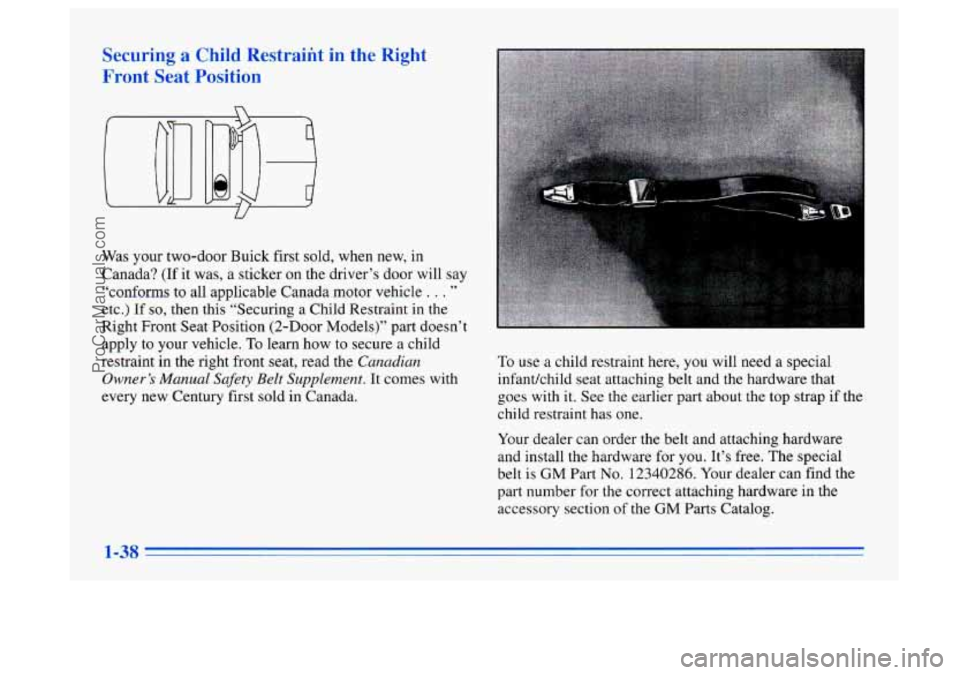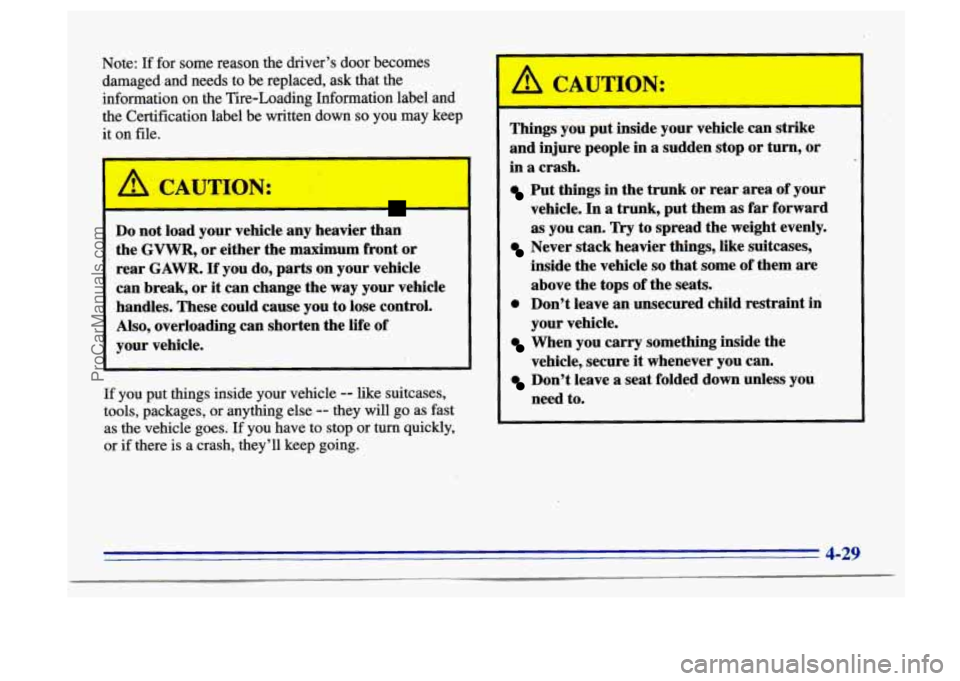Page 50 of 340

ring a Child Restraint in the Right
.t
Seat PC -tic
Was your two-door Buick first sold, when new, in
Canada? (If it was, a sticker on the driver’s door will say
“conforms to all applicable Canada motor vehicle
. . .
etc.) If so, then this “Securing a Child Restraint in the
Right Front Seat Position (2-Door Mode1.s)” part doesn’t
apply to your vehicle.
To learn how to secure a child
restraint
in the right front seat, read the Canadian
Owner’s Manual Safety Belt Supplement. It comes with
every new Century first sold in Canada.
9,
To use a child restraint here, you will need a special
infantkhild seat attaching belt and the hardware that
goes with it. See the earlier part about the
top strap if the
child restraint has one.
Your dealer can order the belt and attaching hardware
and install the hardware for
you. It’s free. The special
belt is
GM Part No. 12340286. Your dealer can find the
part number for the correct attaching hardware in the
accessory section
of the GM Parts Catalog.
1-38
ProCarManuals.com
Page 51 of 340
A CAUTION:
Don’t use the speciaI infantlchild seat attaching
hardware in another vehicle.
If you do, it may not
work well and the child may not be protected
properly in
a crash. The special hardware is for
your vehicle only.
Also, don’t use the special belt for anything but
securing a child restraint in the right front seat.
If an adult or older child uses it, the belt won’t
provide protection and may even increase injury
in a crash.
Once the special hardware is installed, please follow the
instructions
with it and these steps: 1. Unbuckle the automatic lap-shoulder belt by
pushing the button on the buckle. It will stay on
the door, ready to be rebuckled
for use by adults or
older children.
ProCarManuals.com
Page 53 of 340
4. You can make the belt longer by tilting the buckle
5. Put the restraint on the seat. Follow the instructions
and pulling
it along the belt.
for the child restraint.
6. Secure the child in the child restraint as the
instructions say.
The child restraint instructions will show you how.
7. Run the belt through or around the child restraint.
8. Put the hook on the free end through the slot in the
latch plate.
1-41
ProCarManuals.com
Page 54 of 340
9.
10.
To make it tight, pull the belt while you push down
on the child restraint. If the belt won’t stay tight,
switch it end for end.
Push and pull the child restraint in different directions to
be sure it is secure.
Removing the InfantlChild Seat Restraint
1. Push the button on the safety belt buckle and remove
the special latch plate. Leave the latch plate on
the
special belt.
2. Push the spring on the hook near the door and
remove the special belt.
3. Put the belt away in a safe place in your vehicle, so it
won’t
fly around in a crash and injure someone.
4. Remember to reattach the automatic belt again,
once the child restraint is removed. Be sure
it
isn’t twisted.
1-42
ProCarManuals.com
Page 98 of 340
Convenience Net (Option)
Your vehicle may have a convenience net. You'll see it
just inside the back wall of the trunk.
Put small loads, like grocery bags, behind the net.
It can
help keep them from falling over during sharp turns or
quick starts and stops.
The net isn't for larger, heavier loads. Store them
in the
trunk as far forward as
you can. You can unhook the net
so that it will lie flat when you're not using it.
Wagon Cargo Security Cover (Option)
This cover is designed to help conceal articles in the
rear storage area. It pulls out and retracts like a
window shade.
If you have the optional rear-facing third seat, make sure
it is folded down.
A CAUT7N:
An improperly stored cargo coy could be
thrown about the vehicle during a collision or
sudden maneuver. You or others could be
injured.
If you remove the cover, always store it
properly secured. When you put it back, always
be sure that
it is securely reattached.
2-40
ProCarManuals.com
Page 100 of 340

Luggage Carrier (Option)
If you have the optional luggage carrier, you can load
things on top
of a wagon, or on the deck lid of your
vehicle. The luggage carrier has slats attached to the
roof, side rails and adjustable crossrails. The crossrails
can be adjusted by loosening the screws. After moving
the crossrails, be sure to tighten the screws securely.
Don’t exceed the maximum vehicle capacity when
loading your Buick. For more information on vehicle
capacity and loading,
see “Loading Your Vehicle”
in the Index.
To prevent damage or loss
of cargo as you’re driving,
check now and then to make sure the luggage carrier and
cargo are still securely fastened.
NOTICE:
Loading cargo that weighs more than 50 lbs.
(23 kg) for the deck lid or 200 lbs. (90kg) for the
roof on the luggage carrier may damage your
vehicle. When you carry large things, never let
them hang over the rear or the sides of your
vehicle. Load your cargo
so that it rests on the
slats and does not scratch or damage the vehicle.
Put the cargo against the rear rail of the deck lid
carrier and fasten it securely. On the wagon, put
the cargo against the side rails of the roof carrier
and fasten it securely.
Ashtrays and Lighter
Reach under the front edge of the ashtray compartment
to open it.
To remove the ashtray for cleaning, reach
under the ashtray and push up from behind
it.
To clean the rear ashtrays, fully open the ashtray.
Press down on the snuffer
as you pull the ashtray
down and out.
2-42
ProCarManuals.com
Page 154 of 340
W* kter Driving
Here are some tips for winter driving:
Have your Buick in good shape for winter.
You may want to put winter emergency supplies in
your vehicle. Include
an ice scraper, a small brush or broom, a supply
of windshield washer fluid, a rag, some winter outer
clothing, a
small shovel, a flashlight, a red cloth and a
couple of reflective warning triangles. And, if you will
be driving under severe conditions, include a small bag
of sand, a piece of old carpet or a couple of burlap bags
to help provide traction. Be sure you properly secure
these item
in your vehicle.
4-24
ProCarManuals.com
Page 159 of 340

Note: If for some reason the driver’s door becomes
damaged and needs to be replaced, ask that the
information on the Tire-Loading Information label and
the Certification label be written down
so you may keep
it on file.
Do not load your vehicle any heavier than
the
GVWR, or either the maximum front or
rear
GAWR. If you do, parts on your vehicle
can break, or it can change the way your vehicle
handles. These could cause you to lose control.
Also, overloading can shorten the life of
your vehicle.
If you put things inside your vehicle -- like suitcases,
tools, packages, or anything else
-- they will go as fast
as the vehicle goes. If you have
to stop or turn quickly,
or if there is a crash, they’ll keep going.
Things you put inside your vehiclexan strike
and injure people in a sudden stop or turn, or
in a crash.
Put things in the trunk or rear area of your
vehicle.
In a trunk, put them as far forward
as you can.
Try to spread the weight evenly.
Never stack heavier things, like: suitcases,
inside the vehicle
so that some of them are
above the tops of the seats.
0 Don’t leave an unsecured child restraint in
your vehicle.
When you carry something inside the
vehicle, secure it whenever you can.
Don’t leave a seat folded down unless you
need to.
4-29
ProCarManuals.com